By Melissa Greenwald
You know it is time for a change when half of the students in class are lost by the third lesson of a new unit.
I teach third grade in a charter school in Philadelphia. We use Go Math! and each year I have followed Chapter 8: Understand Fractions, exactly as written. In the first lesson, students name equal parts in pictures such as halves, thirds, and fourths, and then move into finding equal shares. By the third day, when we discuss unit fractions, I feel like I have already lost about half of my students. Despite this, I usually trudge along and move into the fourth lesson where students are asked to identify the shaded fraction of different shapes. By the end of the lesson, my students typically have learned the rote skill of counting the number of shaded and total pieces in order to write the fraction. This becomes incredibly evident when we move to putting fractions on a number line and problematic when problem solving with fractions.
By the time we get to Chapter 9: Comparing Fractions, their missed understandings really start to show. My students know how to identify, read, and represent fractions, but they have little idea of what a fraction actually means. They do not see the fraction representing the size of a piece or understand that as the size of the pieces gets smaller as the denominator of the fraction gets larger. They do not understand how $latex \frac{1}{2}&bg=ffffff$ could possibly be the same as $latex \frac{2}{4}&bg=ffffff$, nor can they tell you the difference between the numerator and denominator beyond “the number on top and the number on bottom.” Most concerning to me is that, as fractions become incredibly frustrating for them, they avoid them if at all possible and certainly don’t enjoy them.
I have tried so many things to make fractions less dreaded. I have used some cutesy activities like bringing in a tray of brownies and cutting it into fractions (for all of us to eat) and connecting everything to sharing a pizza. None of it has truly helped students gain the deep understanding they need to be successful with fractions. I also have tried using the Go Math!-supplied fraction tiles, which I love, but they are an organizational nightmare. I cannot even tell you how many times have I found a twelfth on the floor with no idea from whose fraction tile bag it came. I have found students view these tiles as a way of finding an answer without actually understanding why they got the answer they did. Trays of brownies, drawings of pizza, and fraction tiles all have their place, but they were not addressing the root cause of the problem I was seeing. So this year, I embarked on a journey to change my teaching in order to help my students build deeper understandings of fractions so they could grow to love them.
This year, I started Chapter 8 by having students build their own fraction strips with construction paper as opposed to giving them the premade fraction tiles. We created one whole and wrote on it, “one whole.” We then talked about how we could share that whole fairly between two friends and cut another strip of equal size into the two equal pieces. We wrote “half” on each one and repeated this process with thirds, fourths, sixths, and eighths. Before each cut, we discussed how we could cut the pieces fairly and used folding to get the eighths based on what we knew about fourths.
After we had all of our fraction strips cut and labeled, we started our discussion. In their table groups, I asked students to simply notice things about their fraction strips. As I overheard some table discussions about fraction comparison, I said to one group, “Wait a second. This one is called eighths and this one is called thirds, but the eighth piece is smaller than the third piece even though three is smaller than eight. Why is that?” The room was buzzing with ideas! When I called them back together, many commented that it was weird and sort of the opposite of what we typically know about numbers.
One student described the idea this way: “If I had a carrot and I cut it into just three pieces, those pieces are going to be pretty big, but if I cut it into eight pieces, I have a lot more pieces so those pieces are going to be smaller.” I turned to my apprentice teacher as she stood there in shock! The concept of the SIZE of the piece getting smaller as the NUMBER of pieces gets larger had eluded my 3rd graders for as long as I have been teaching fractions. Now students were coming up with this idea on their own!
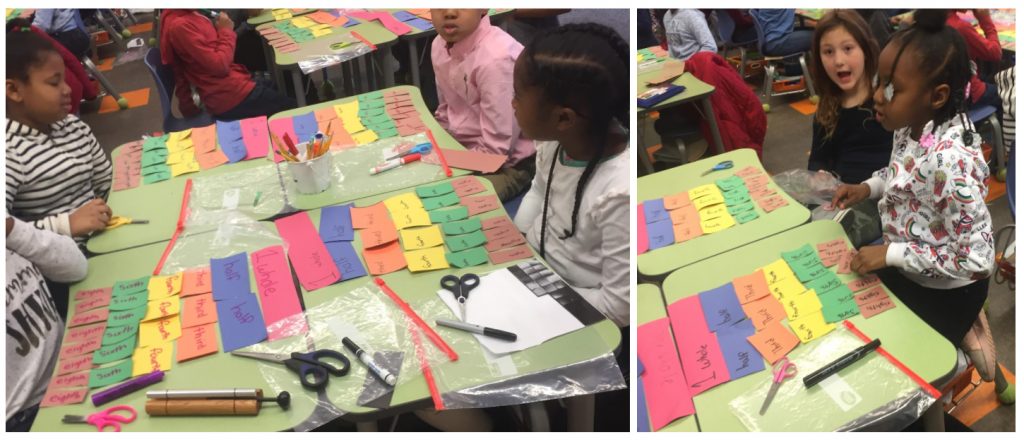
Students deep in discussion with their fraction strips.
I wanted to dive deeper into their understanding, so I asked my students what a hundredth might look like. Immediately, the room buzzed with chatter. I saw many students showing tiny size shapes with their fingers and when I asked one student why he thought it would be so small, he said “Well you have so many pieces, so to make one whole they would need to be really tiny!”
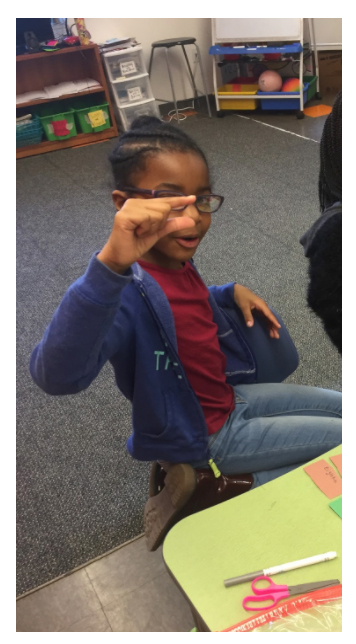
A student showing me the size of one hundredth.
I was so impressed and wanted to learn more about their thinking, so I asked the class which would be larger: five hundredths or one half. Since they had no visual or manipulative to show one hundredth, they needed to reason about the size of the pieces more abstractly. There was quite a bit of debate about this and eventually, they came to the conclusion that is was really strange because you would have FIVE pieces, but they would be so tiny that they still would be smaller than one half. One student even called out, “Yeah, you would need 50 one hundredths to equal one half.” When we had only a few minutes left, I showed them how mathematicians notate fractions and we added labels to the back of our fraction tiles.
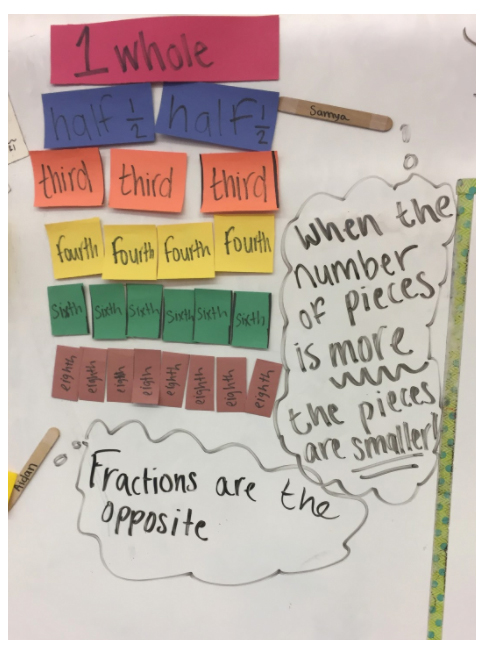
Our board at the end of lesson. Everything written is an exact quote from a student.
They breezed through labeling fractions and when we hit the lesson where students are asked to label something other than a unit fraction—which typically caused confusion in years past—they did beautifully. Unlike their usual mixing up of the numerator and denominator when presented with a fraction greater than 1, my students were easily able to tell me that you would have 10 of the one-eighth pieces. Not only were they getting through the work, they were enjoying what they were doing, feeling confident in themselves, and having productive conversations with each other along the way.
I decided to replace the number line lesson in Go Math! with another lesson I hoped would build on what the students knew about both number lines and fractions. I wanted them to think about how the relative distance between the numbers on a number line might change based on the numbers, so we plotted numbers such as 0, 3, 10, and 217, changing the spacing on our number line as we went. Then it was time to put them to work in their groups. I put a piece of masking tape, representing a number line, on the floor for each table group and gave them these fractions on Post-its: 0, 1, $latex \frac{1}{2}&bg=ffffff$, $latex \frac{3}{4}&bg=ffffff$. I had them debate about where each one would go and share their findings. It started out rough when many groups put zero right next to one and then $latex \frac{1}{2}&bg=ffffff$ next to that. I called the whole class together and brought out our fraction strips again. We compared one whole to $latex \frac{1}{2}&bg=ffffff$ and many of them quickly made changes. As they mastered those numbers, we gave them more numbers: 2, $latex \frac{5}{4}&bg=ffffff$, $latex \frac{1}{10}&bg=ffffff$, $latex \frac{7}{8}&bg=ffffff$. As I walked around to listen to their discussions, I kept encouraging them to use their fraction strips. One student told my apprentice teacher and his group that he thought that $latex \frac{7}{8}&bg=ffffff$ would go really close to 1 because it is only $latex \frac{1}{8}&bg=ffffff$ away from 1 whole. Another group told me that they had decided $latex \frac{5}{4}&bg=ffffff$ would go just after 1 because $latex \frac{4}{5}&bg=ffffff$ is one whole and $latex \frac{5}{4}&bg=ffffff$ would “be just one bigger.”
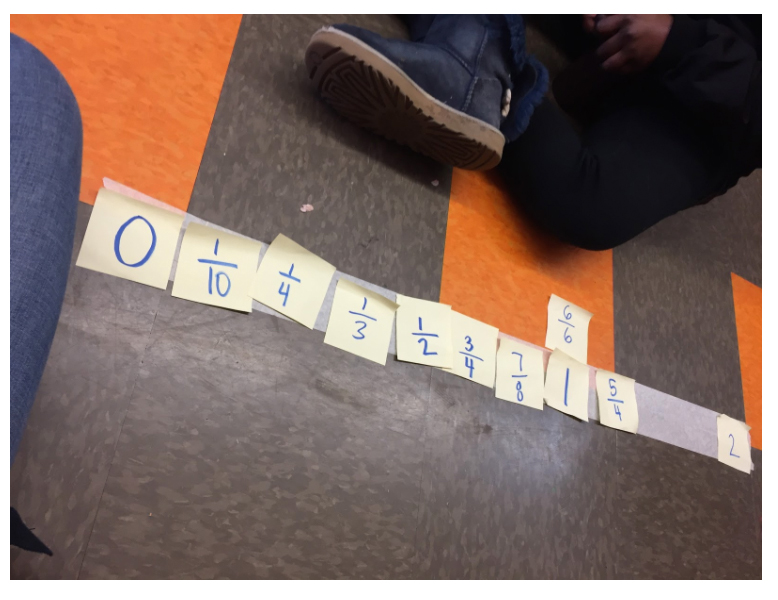
One groups work.
We came back together as a whole group afterwards to place all of our numbers on a number line together in the front of the room, discussing the placement of each one. I ended with a quick exit ticket to check for understanding. The results of the exit ticket were mixed. Most students ordered the fractions correctly, but did not attend to the distance between them appropriately. Considering we still have two more days focused just on fractions on a number line, I was really happy that about a third were able to do this challenging work! Last year, at the end of the year, I think only one or two of my students could have successfully done the exit ticket!
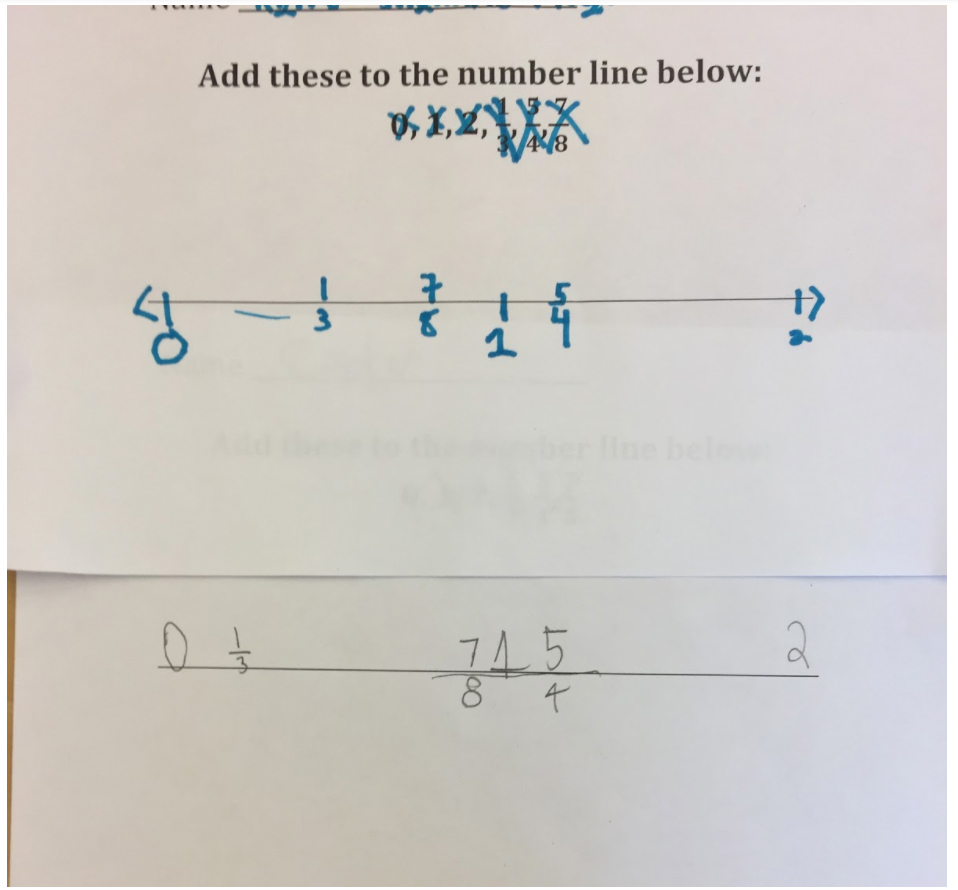
Two students’ exit tickets
As most teachers do, I worried about adding lessons because it adds so much time to each unit. However, even though I added lessons to this unit, it didn’t add any days to my unit because I was replacing the Go Math! lessons. It was a bit of prep work at first: cutting construction paper, putting tape on the floor, and writing fractions on post-its. But it was less work than baking brownies and organizing hundreds of fraction tiles. All work aside, the most rewarding part for me was talking to my students afterwards about fractions. I asked each of them, “What do you think about fractions?” and every single student had positive things to say. Their responses ranged from “They are so easy!” to “I love fractions!” to “I think fractions are kind of easy and really fun!” We take our chapter text week and I am so excited to see how my students do.
Next Steps
Have you made any successful adaptations to your fraction curriculum? I would love to hear about what you did, why you made those changes and how it worked!
